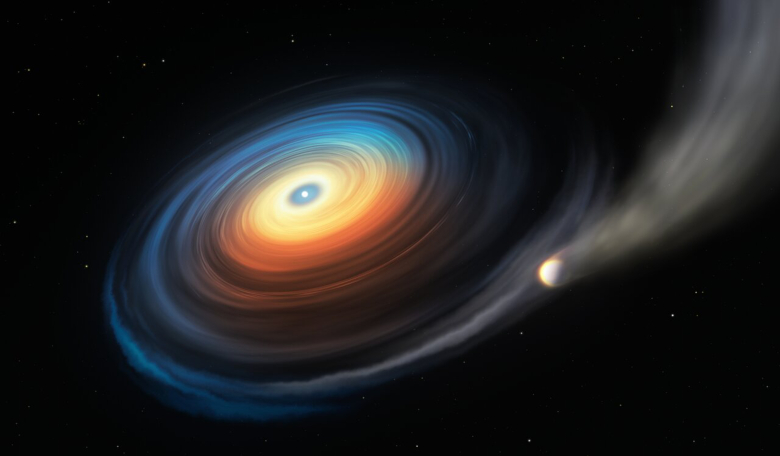In a far-off system that hints at what our own Solar System might look like in the distant future, astronomers have for the first time observed a Neptune-sized planet orbiting a hot white dwarf, that is so close, it’s atmosphere is being stripped away.
Five billion years from now, our Solar System will look a lot different than it does right now. It will be reduced to a handful of large planets orbiting a small, very dense star that once used to a glowing ball of burning hydrogen and helium. The three inner rocky planets will most likely be gone, Mars might survive and even if Earth does not get consumed, its seas will be boiled and its atmosphere stripped away.
There is no guarantee that the outer gas giants won’t be affected either.
This is because stars like our Sun, once they run out of fuel, begin to puff up into red giants, becoming hundreds of times larger as they shed their outer layers. Any nearby planets will be engulfed in the transformation and when the star starts to shrink again, any life-giving light will dissipate and all that will be left is a burnt-out core, packed with degenerate matter. And who knows what gravitationally affect this super-dense replacement central star might have with what's left over when the terrestrial planets disappear.
As gruesome as this might seem, white dwarfs can still host planets, and many of these star systems are thought to exist in our galaxy. However, until now, scientists had never found evidence of a surviving giant planet around a white dwarf.
“It was one of those chance discoveries,” says researcher Boris Gänsicke, from the University of Warwick in the UK, who led the study, published today in Nature.
Having waded through data on around 7000 white dwarfs observed by the Sloan Digital Sky Survey, the team found one that turned out to be unlike any of the others; it had traces of hydrogen, oxygen and sulphur – elements that are similar to those found in the deep atmospheric layers of icy, giant planets like Neptune and Uranus
Follow-up observations using the X-Shooter instrument on ESO’s Very Large Telescope, led the team to discover that these elements were in a disc of gas swirling into the white dwarf, and not coming from the star itself.
“It took a few weeks of very hard thinking to figure out that the only way to make such a disc is the evaporation of a giant planet,” says Matthias Schreiber from the University of Valparaiso in Chile, who computed the past and future evolution of this system.
After combining observational data with theoretical models, the team now think that the unnamed doomed planet is icy and large—at least twice as large as the star.
It whips around its blisteringly hot host star named WDJ0914+1914, which has a temperature of 28 000 degrees Celsius (five times as hot as the Sun), in just 10 days.
The high-energy photons crammed inside the dead star are gradually blowing away the planet's atmosphere and while most of the gas escapes, some of it is pulled into a disc swirling into the star at a rate of 3000 tonnes per second. This disc is what gives away the presence of the otherwise hidden Neptune-like planet.
“This is the first time we can measure the amounts of gases like oxygen and sulphur in the disc, which provides clues to the composition of exoplanet atmospheres,” says Odette Toloza from the University of Warwick, who developed a model for the disc of gas surrounding the white dwarf.
What’s more, according to the international team of researchers who found it, the exoplanet orbits the white dwarf at a distance of only 10 million kilometres, or 15 times the solar radius. This would place it deep inside the zone of the red giant.
This implies, say the team, that at some point after the host star became a white dwarf the planet moved closer to it, possibly through the gravitational interactions with other planets in the system, meaning that more than one planet may have survived the destructive evolution of the host star.
The discovery opens up a new window into the final fate of planetary systems says Gänsicke. “Until recently, very few astronomers paused to ponder the fate of planets orbiting dying stars. This discovery of a planet orbiting closely around a burnt-out stellar core forcefully demonstrates that the Universe is time and again challenging our minds to step beyond our established ideas,” concludes the lead author.











